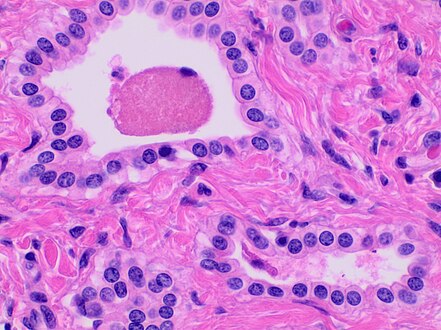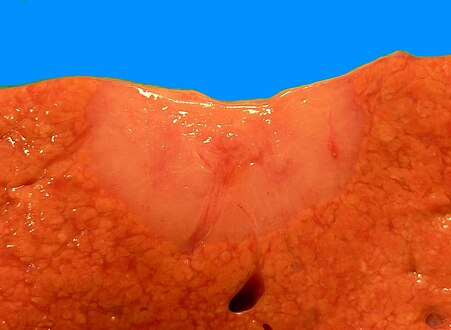Желчный проток Гамартома
| Желчный проток Гамартома | |
|---|---|
 | |
| Гистопатология желчного протока Гамартомы, низкое увеличение, пятно H & E , демонстрируя хорошо разграниченное поражение. |
проток Гамартома или желчный желчного протока - это доброкачественные поражения внутрипеченочного желчного протока . [ 1 ] Они классически связаны с поликистозным заболеванием печени , что можно увидеть в контексте поликистозной болезни почек , и представляют собой развитие пластины печени. [ 2 ]
Признаки и симптомы
[ редактировать ]Большинство пациентов бессимптомно. Когда пациенты действительно присутствуют с симптомами, наиболее распространенным симптомом является боль в животе . Другие симптомы включают лихорадку , потерю веса и желтуху . [ 1 ]
Причины
[ редактировать ]Гамартомы желчных протоков - это дефекты, возникающие в результате неспособности инволюции эмбрионального желчного протока , которые влияют на небольшие межлобулярные желчные протоки. Пациенты с поликистозным заболеванием почек и поликистозой печени гораздо чаще их имеют. [ 1 ]
Диагноз
[ редактировать ]-
Histopathology of a bile duct hamartoma, high magnification, H&E stain. It shows typical features of bile duct hamartoma: Small to medium sized, irregularly shaped bile ducts lined by bland cuboidal epithelium (may also be flattened). Prominent intervening collagenous stroma. Bile ducts containing eosinophilic debris (may also contain inspissated bile)
-
von Meyenburg Complex in ultrasound. Numerous little cysts with ringdown artefacts.
Laboratory findings include high transaminase levels, raised gamma-glutamyl transferase or alkaline phosphatase levels, increased C-reactive protein, hypoalbuminemia, and hematologic abnormalities like thrombocytopenia, leukopenia, leukocytosis, and anemia.[1]
At CT scans, bile duct hamartomas appear as small, well-defined hypo- or isoattenuating masses with little or no enhancement after contrast administration.[3] At MRI, they appear hypointense on T1-weighted images, iso- or slightly hyperintense on T2-weighted images, and hypointense after administration of gadolinium based contrast-agent.[3]
Eponym
[edit]The eponymous terms (von Meyenburg complex, Meyenburg complex) are named for Hanns von Meyenburg.[4][5]
Additional images
[edit]-
Micrograph of a bile duct hamartoma. Trichrome stain. Intermediate magnification
-
Micrograph of a bile duct hamartoma. Trichrome stain, high magnification
-
Low magnification micrograph of a bile duct hamartoma. Trichrome stain.
-
Gross pathologic appearance of a large bile duct hamartoma.
See also
[edit]References
[edit]- ^ Jump up to: a b c d Sheikh, Abdul Ahad E; Nguyen, Anthony P; Leyba, Katarina; Javed, Nismat; Shah, Sana; Deradke, Alexander; Cormier, Christopher; Shekhar, Rahul; Sheikh, Abu Baker (May 26, 2022). "Biliary Duct Hamartomas: A Systematic Review". Cureus. 14 (5). Cureus, Inc.: e25361. doi:10.7759/cureus.25361. ISSN 2168-8184. PMC 9236677. PMID 35774682.
- ^ Desmet, VJ (Jan 1998). "Ludwig symposium on biliary disorders--part I. Pathogenesis of ductal plate abnormalities". Mayo Clin Proc. 73 (1): 80–9. doi:10.4065/73.1.80. PMID 9443684.
- ^ Jump up to: a b Horton, KM; Bluemke, DA; Hruban, RH; Soyer, P; Fishman, EK (Mar–Apr 1999). "CT and MR imaging of benign hepatic and biliary tumors". Radiographics. 19 (2): 431–51. doi:10.1148/radiographics.19.2.g99mr04431. PMID 10194789.
- ^ synd/1693 at Who Named It?
- ^ H. von Meyenburg. Über die Zyztenleber. Beiträge zur pathologischen Anatomie und zur allgemeinen Pathologie, Jena, 1918, 64: 477-532.
Further reading
[edit]- Zheng, Rong Qin; Kudo, Masatoshi; Onda, Hirokazu; Inoue, Tatsuo; Maekawa, Kiyoshi; Minami, Yasunori; Chung, Hobyung; Kitano, Masayuki; Kawasaki, Toshihiko (2005-12-19). "Imaging findings of biliary hamartomas (von Meyenburg complexes)". Journal of Medical Ultrasonics. 32 (4): 205–212. doi:10.1007/s10396-005-0051-1. ISSN 1346-4523. PMID 27277490. S2CID 25856248.





